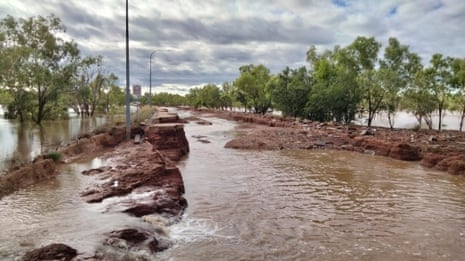Western Australia’s “worst ever” flood has further highlighted the vulnerability of Australia’s supply chains, experts say.
On Saturday, record levels of water were pouring down the Fitzroy River, which had created a 50km-wide inland sea. The water across the Kimberley region had shut down parts of the crucial Great Northern Highway, damaged the bridge at Fitzroy Crossing and inundated the airstrip. And 105 people had been relocated from the region, with more expected to be airlifted out in the coming days.
In the afternoon, the state government said better weather had finally allowed planes to land at Fitzroy Crossing, carrying thousands of kilograms of food into the communities.
Over the past few years, the coronavirus pandemic caused global shortages of many crucial items – particularly when China shut many of its factories. Covid-related staff shortages in Australia worsened the problem, as did floods and bushfires.
Russia’s invasion of Ukraine has also interrupted energy supplies, pushing up prices. And China’s Covid wave is now threatening more chaos.
But in WA, as the flood waters shut down main access routes in the Kimberley, they forced a swift shift to triple road trains that will now travel enormous distances to get food and medical supplies to vulnerable communities.
Curtin University supply chain expert Associate Professor Elizabeth Jackson said the decision to allow the triple road trains was a good example of a rapid response and that the pandemic, Russia’s invasion of Ukraine and now the floods were examples of the need for supply chains to become more nimble.
“One of the things Australians have become so tired of in the last three years is how slowly things have moved, with the significant disruptions we have encountered,” she said.

“The speed at which the national trucking association and the state government worked together so rapidly to provide for the ability of triple road trains to access routes that could get supplies – and big quantities of supplies – to where helicopters and light aircraft can land is just extraordinary.”
Floods and fires disrupting freight delivery was going to become the “new normal”, she said, adding that a multidisciplinary approach was needed to solve it.
“We need biologists, engineers, local people with local knowledge,” she said. “We’re not alone in this. The strategies that supply chains are employing is essentially going against the grain of usual supply chain strategy, which is to find a quick and reliable supplier and lock in massive quantities of the product you want for years to come.
“Now, we need things like having multiple suppliers, ordering in small quantities, being nimble and agile, pivoting quickly when something goes wrong.”
Governments collaborating with industry was one lesson to take out of the flood response, she said.
When the pandemic began, Australia’s first noticeable shortages included items such as toilet paper, as people stripped shelves of necessities. Then international flights slowed and there was a shortage of shipping containers and pallets, which slowed the movement of freight around the world. More specific shortages, such as semiconductors out of China, led to long waits for phones and cars.
Last year, the pandemic, fertiliser shortages and natural disasters pushed grocery prices up.
Jackson said that in recent decades supply chains became so efficient that it had “completely slipped our minds how hard it is to put things together” until it all broke down.
By Saturday, 3,000kg of food had been flown into flood-affected WA communities as authorities headed to Fitzroy Crossing to listen to people’s “frustrations” at a community meeting.
after newsletter promotion
The emergency services minister, Stephen Dawson, said Australian Defence Force planes and other aircraft were now able to use the airstrip at Fitzroy Crossing as the weather had improved. He also warned that record water levels, the fallout from ex-tropical cyclone Ellie, which has been dumping water in the region for days, were set to hit Looma and Pandanas Park.
Evacuations have continued, and Dawson said while there had been a “reticence” by some people to leave their homes, those attitudes had changed, while the authorities were taking food to those who chose to stay.
“It’s really an opportunity for us to listen and hear their frustration. I know they’re frustrated,” Dawson said.
“I am aware though, having spoken to people this morning, there is a sense of relief now as planes have started to fly in and land and drop off food supplies.”
The ADF planes will be joined by other aircraft including Chinooks to continue the resupply effort, while barges will be used to take supplies into Broome.
The fire and emergency services commissioner, Darren Klemm, said that effort will “really ramp up today and in the days ahead” as the weather has improved.
The WA government also announced $3m for a distress fund set up by the Perth lord mayor, Basil Zempilas.
The Western Roads Federation chief executive, Cam Dumesny, said Australia needed to “move away from the ‘just in time’ to ‘just in case’”.
As the head of the peak body for the road transport industry in WA, he has seen first-hand how swiftly natural disasters such as floods can sever critical parts of Australia’s freight network.
“We need to look at hardening the supply chains,” he said. “They’re so disrupted, so vulnerable. And those climate-related disruptions will keep occurring.”
